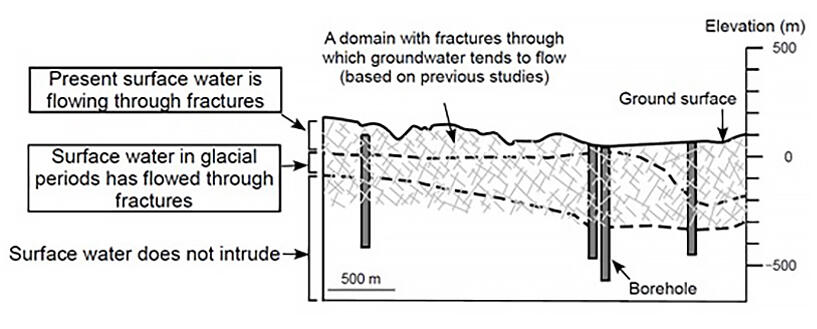Geological disposal of high-level radioactive waste requires the selection of areas where radioactive material migration is unlikely to occur. Researcher Akihito Mochizuki and Senior Researcher Eiichi Ishii of the Horonobe Underground Research Center, Sector of Nuclear Fuel, Decommissioning and Waste Management Technology Development, Japan Atomic Energy Agency (JAEA) announced on June 6th that they have devised a technique to determine both places in which groundwater flow currently occurs along faults and fractures and places in which it doesn't, using water quality data from boreholes dug from the ground surface. From this, the researchers have learned that it is possible to discern the quality of groundwater by comparing hydrogen and oxygen stable isotope ratios. It is hoped that this outcome will be useful for selecting candidate sites for geological disposal and fixed positions for waste bodies.

Provided by JAEA
Applicable for selecting candidate sites for geological disposal of high-level radioactive waste
To ensure the confinement capabilities of geological disposal, it is necessary to select areas in which either the normal fractures in the ground do not connect, or in which groundwater flow does not occur even if the fissures do connect.
In response to this issue, this research group considered the idea that the ratio of stable isotopes (isotope ratio) of hydrogen and oxygen reflects the source of the water and investigated if it is possible to determine whether groundwater flows in each fracture (cracks in rocks, including faults, that can be observed with the naked eye). Groundwater flow in fractures deep underground is extremely slow, making it difficult to measure its flow speed, and a technique other than direct measurement was needed.
First, the group carried out a detailed investigation of water quality data, including isotope ratios, for groundwater in fractures in rock layers (fracture water), collected from boreholes dug from the surface of the ground in multiple locations in the Horonobe area, and for groundwater (pore water) contained in the spaces between the grains (cannot be observed with the naked eye) of core rock samples from the boreholes. The fracture water was collected by using a pump to draw up water from sections several meters long to several dozen meters long established in the boreholes. The pore water was extracted and collected by compressing groundwater contained in the spaces between the grains of core rock samples from boreholes. Both the fracture water and the pore water were collected from several locations at different depths from the surface.
The results showed that, compared to the isotope ratio of the pore water at different depths, the isotope ratio of the fracture water in some of the shallow borehole sections was a similar value to that of the surface water; the researchers thought that the present-day surface water flowed along the fissures, and the surrounding pore water came from a different source. On the other hand, in some of the deep sections, the isotope ratio of the fracture water was the same as that of the surrounding pore water, showing a different value to the present-day surface water, so the researchers believed that groundwater flow through the fissures was not currently occurring, or was very slow.
According to past investigations of this region, it is permeated by two different types of surface water: the present-day surface water and surface water from a glacial period (the most recent was around 10,000 years ago) that had a colder climate than now. This is not uniform, but there are areas in which there is present-day surface water near the surface and glacial period water deeper underground; the researchers are aware that it is structurally easy for surface water to flow along fractures up to around 300 meters from the surface, including these areas, and that groundwater does not permeate areas in the vicinity of 400-500 meters deep.
In light of this, when the research group analyzed all the data collected, it became clear that in Horonobe there are areas in which water does not flow along fractures, even within areas with structures that make it easy for water to permeate from the surface due to the high connectivity of the fractures. There were no gaps in fracture connectivity or ease of passage (permeability coefficient) in these areas.
Dr. Mochizuki commented, 'At the moment we are considering whether we can determine this using a different component of water quality. If we can combine this with another technique, I think we'll be able to ensure even more validity.'
Journal Information
Publication: Hydrogeology Journal
Title: Assessment of the level of activity of advective transport through fractures and faults in marine deposits by comparison between stable isotope compositions of fracture and pore waters
DOI: 10.1007/s10040-022-02466-9
This article has been translated by JST with permission from The Science News Ltd.(https://sci-news.co.jp/). Unauthorized reproduction of the article and photographs is prohibited.




